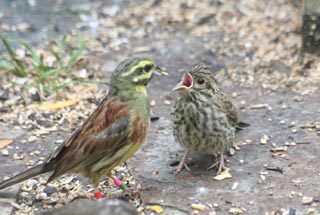 Spring is here! With the arrival of the swallows and the unseasonally warm conditions, many birds are well ahead with breeding plans for the season. Our cirls have already been seen forming pairs and in some cases carrying nesting material, though they don’t usually starting breeding until May.
Spring is here! With the arrival of the swallows and the unseasonally warm conditions, many birds are well ahead with breeding plans for the season. Our cirls have already been seen forming pairs and in some cases carrying nesting material, though they don’t usually starting breeding until May.
After the successful season in 2010, we are hoping for another population increase this year. The early signs are promising, with more birds being seen than ever before at this time of year. In general, we do not suffer high mortality through the winter because, despite the harsh conditions before Christmas, Cornwall still fares better than the rest of the country. Without prolonged snow cover, and with our food provisions strategically placed near known wintering sites, the cirls are better able to cope with these arctic temperatures. Plus there is plenty of suitable winter habitat in place on local farms, with many farmers planting bird seed mixes to give the birds an extra boost during the season.
Over the winter the birds have spread into new areas, often finding their way to sites where sympathetic management is in place. They spend the winter in small groups on spring barley stubbles and bird seed mixes. Their dispersal has now increased our monitoring range and established an outpost in a new site, where we hope they will breed this spring. Although they now occupy a number of areas – north of Portscatho, South towards St Anthony, and across the Percuil River towards St Just and St Mawes – they are still very difficult to track, especially at this time of year, when they begin to leave their winter habitat and form territories on permanent pasture.
So we now have as many birds as ever before, and a much better demographic as well. Not only does the population include more experienced birds in their second or third year of breeding, but also it contains a higher proportion of unringed birds – around 50{c8c3b3d140ed11cb7662417ff7b2dc686ffa9c2daf0848ac14f76e68f36d0c20}. This is important as these birds are those born in Cornish nests, and they have benefitted from extra parental care that we can not give to the released birds. This makes them a bit more world-wise, and they seem to be slightly better equipped to deal with the rigours of day to day life than their ringed counterparts.
There will be another batch of releases this summer, as more birds arrive from Devon to be added to the Cornish population. The work with the local farming community continues, and as ever their support has encouraged the population to expand. And our dedicated team of volunteers will continue to search for the birds through the coming months. You too can play your part! Some of you may have noticed a cirl bunting postcard arriving through your letterbox recently. We know of some birds using gardens around the villages to feed, and possibly to breed! If you have seen cirl buntings we would love to hear from you, as this helps build up a more accurate picture of how well the birds are doing. So if anyone has any sightings, would like to commit to regular voluntary work, (*see below) or simply wants more information, please feel free to contact me on 07736 792524 or at stuart.croft@rspb.org.uk
Stuart Croft
RSPB Cirl Bunting Reintroduction Project Field Officer
*In the RSPB volunteers are a major resource and make a vital contribution to the RSPB’s aims to take action for the conservation of wild birds and the environment. On a project like this we would need someone with good field identification skills and reasonable fitness who could commit to at least one day each fortnight, since it requires regular work to become familiar with the ring identification and the monitoring area. We also offer residential placements during winter. For more information see www.rspb.org.uk or contact Stuart Croft – details above.

